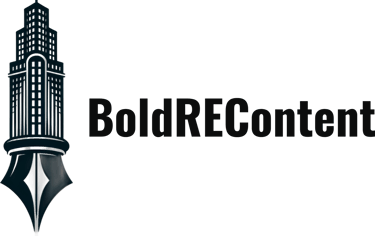The ROI of Real Estate Content Writing in 2025
Create good content and prove its financial worth with data. This article will teach you how to measure the ROI of real estate content writing, and how to create content that produces real, tangible results.
REAL ESTATE CONTENT WRITING
Agnes A. Gaddis
11/21/202529 min read
There is an opportunity in content and SEO right now that’s impossible to ignore.
While most marketers focus on the shiny object (AI, GEO), there’s an opportunity to generate almost unbelievable returns if you approach content writing and SEO with a data-backed strategy.
The reality is: The Pareto law applies. 80% of firms are throwing money away on content with no real strategy and seeing little or no measurable results. Yet, a small group (20%) of marketers who actually get SEO and content marketing see returns exceeding 500%.
In real estate, the potential is even greater. Real estate companies that employ a concrete, data-backed content + SEO strategy achieve an average ROI of 1,389% (3-year average) according to the latest analysis from First Page Sage, a reputable marketing agency.

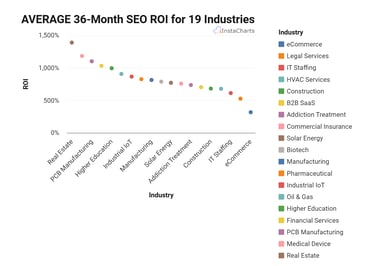
This means $1 spent on top-notch real estate content writing generates about $14 on average. An incredible return on investment!
It raises a critical question for any executive managing a marketing budget: Why are four out of every five companies burning capital on a marketing channel with such proven potential?
In this article, I attempt to answer that question. But before I do, let me quickly address the elephant in the room: the perception gap and the strategic opportunity it creates.
It’s essentially difficult to track the effectiveness of content marketing as a marketing engine, unlike channels like PPC.
But this is the opportunity. Over the next 5-10 years, knowing how to measure content marketing ROI and tracking the right content marketing ROI metrics will likely separate the winners from the rest.
This is somewhat of an argument against the “content marketing is dead” or “content marketing will die in 5 years” rhetoric. The only way this could happen is:
If shoddy AI content proliferates and turns everything into shit. This isn’t going to happen. Content must inherently conform to a standard.
AI content gets insanely good so much so that people literally choose it over human content. I don’t see this happening either because AI doesn’t have experience nor intuition. It can only work with what you give it and whatever resources it can access.
If measuring content marketing ROI metrics becomes as easy as publishing a piece of content and checking a dashboard to see orders or meetings booked as a result of that piece of content.
This would level the playing field for businesses creating content. Who knows? This might happen in the future, but there are too many variables here as we’ll soon see.
The opportunity right now is that while most REI companies are operating with a major blind spot or disproportionately spending the lion share of their marketing budget on PPC, any company that is willing to do the work of properly measuring their content’s ROI is likely to both outrank and outlast them.
In this guide, I’ll show you how to measure content marketing ROI, so you can close that measurement gap and confidently capture those opportunities your competitors are missing.
What is ROI in Real Estate Content Marketing?
For real estate investment firms, content ROI bears little resemblance to typical marketing metrics. This is not about website traffic or social media engagement.
Content ROI in real estate investment means an increase in paying clients (REIs), assets under management (AUM), new sign ups/booked appointments, or seller inquiries.
The calculation itself is straightforward, using the classic formula:
(Revenue from Content - Content Marketing Spend) ÷ Content Marketing Spend x 100 = ROI %)
Consider this realistic real estate calculation: A commercial real estate firm (Company A) spends $15,000 monthly on real estate content writing, SEO, and distribution.
Over 12 months, their content generates 80 qualified investor leads through organic search. Seven of those investors commit capital totaling $10 million, generating $500,000 in management fees and acquisition commissions (5%).
ROI = ($500,000 - $180,000) ÷ $180,000 × 100 = 177% in year one.
Conversely, consider this: Another commercial real estate firm (Company B) spends $15,000 monthly on content creation and distribution.
Over 12 months, that content generates 18 qualified investor leads through organic search. Three of those investors commit capital totaling $2.4 million, generating $120,000 in management fees and acquisition commissions.
ROI = ($120,000 - $180,000) ÷ $180,000 × 100 = -33% in year one.
In the first year, the ROI is negative. This is where most people pack it in.
But focusing on year 1 ROI is flawed when it comes to content investments. You really start seeing the results of your content marketing by the second year. SEO ROI statistics show that the lifetime value of 1 blog post is 700 days. That is, about 2 years.
With the cumulative effect of what they did last year, plus the effect of initiatives they are working on in year 2, and let’s say they invested about $20,000 to fix their CRO and lead funnel, it’s easy to assume they’d get the same (or even better) results as Company A in the second year.
Year 2 ROI: ($500,000 - $380,000) ÷ $380,000 × 100 = 31.57%
Now they didn’t only break even, they made good profit. The cumulative effect of everything they did would mean that by year 3, they are really making the bank with content marketing.
Content is an asset, not a campaign. It’s all about the cumulative effect. That investor would continue to generate revenue in subsequent years, and the accumulation of content would continue to attract new prospects.
Now, the difference between Company A and Company B is strategy. The problem is, the majority of brands are Company B. Their content strategy is wack. But here are two scenarios that often happen:
They see the negative ROI of content marketing in year 1 and immediately shut down the blog.
They do not track and therefore don’t know what kinds of content drive results for them. Since they don’t track results, they do not understand why they need to fix their lead funnel, nor the strategic content pieces and types they need to focus on.
This is exactly why most real estate companies investing in content fail to see the true ROI of content marketing or truly benefit from professional real estate content writing services.
The measurement challenge
The biggest challenge in content marketing isn’t trying to come up with the perfect strategy, it’s sticking with it long enough for it to deliver results.
We’ve established that content marketing is superior to most other marketing channels. Organic leads from content marketing convert at 14.6% compared to leads from traditional outbound methods (like costly roadshows and networking events) that convert at around 1.7%.
That is, you have an 8X higher chance of closing on a lead that reached out to you or subscribed to your list because they read your content versus a lead from a networking event.
So why are many real estate investors closing the lid on this marketing channel?
It’s because they lack the patience it demands. Businesses want immediate results. We all want instant gratification. It’s human nature!
The long-term nature of content marketing requires us to go against the grain. It’s a test of a person or a business exec’s discipline and perspective.
The opportunity inherent in this model is that it weeds out competitors that lack patience, while players that have the conviction to invest and wait for the “compound effects” to take hold succeed.
Most real estate firms should see positive ROI from content investments within 6-12 months, with peak performance occurring in years 2-3 as compounding occurs. But that’s a long wait for many businesses and so they give up on content marketing too soon.
And then they fall back on PPC, which doesn’t have this compounding advantage. With PPC, once you pause spending, you stop getting results. But many REI businesses would rather invest heavily in PPC.
Apart from this, measurement is hard. Well it’s not hard, as you’ll soon see. Most marketers just don’t know how to do it, do it wrong, or do not prioritize the work of setting up measurement systems.
This is especially true in real estate content writing, where brands often invest without understanding performance benchmarks.
You can’t just look at the last thing a customer clicked before they contacted you and claim that’s what led to conversion. But that’s the most common attribution model marketers use (last-click). It can work with PPC ads, but it completely misrepresents the value of high-value real estate content writing.

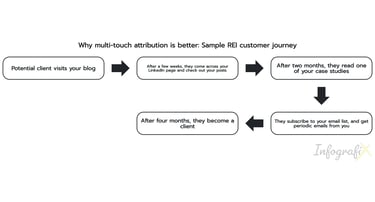
With content, you’re dealing with sophisticated customer journeys. A potential investor might discover your firm through a blog post, consume several market reports, and ultimately convert after reading a case study three months later.
The complications arise from the long, windy path the customer takes versus the straight path from a PPC landing page. But it’s a challenge worth tackling.
If as a business, you can answer the question, “what percentage of our leads or sales came from content?” with hard data, content no longer becomes a marketing expense. It becomes a predictable, high-performing investment that you can confidently defend and scale.
The measurement challenge presents us with two opportunities:
Outlast competitors: Play the long game and win with compounding, while others get weeded out.
Outrank competitors: Create measurement systems that help you prove the value of content to stakeholders; double down on high-ranking content and revenue-generating content.
Other content marketing ROI metrics
You don’t need to wait for revenue figures to know if your content is working. Direct revenue is the ultimate measure of success, but it is a lagging indicator.
You have a set of leading indicators that act like a dashboard, giving you confidence that you're moving in the right direction. These show you your content strategy is on track to produce good financial returns.
1. Cost Per Lead (CPL)
CPL = Total Content Marketing Spend ÷ Number of Leads Generated.
Divide your monthly content budget by the total number of qualified inquiries generated through organic channels to get your CPL.
If you spend $6,000 monthly on content and generate 8 qualified leads, your CPL is $750. You want to compare this against your PPC cost per lead—most firms see content CPL decrease over time while PPC costs consistently rise.
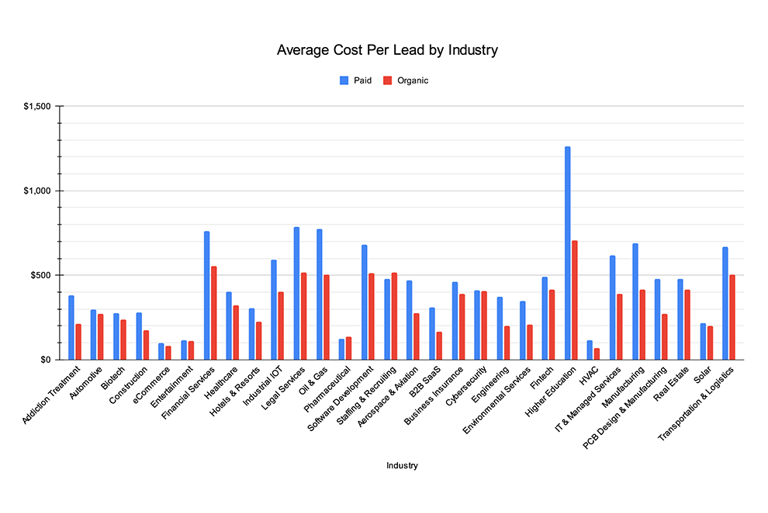

The average organic CPL for the real estate industry is $416. So you’d want to bring your cost per lead down to around $400. The average paid CPL is $480.
2. Conversion rate
Conversion Rate = (Conversions ÷ Total Visitors) × 100
What percentage of your website’s visitors completed your desired action—whether downloading a market report, requesting a consultation, or subscribing to your newsletter? Real estate content writing typically sees conversion rates between 2-5%.
3. Organic traffic growth
What are the raw traffic numbers for any single month? If you already have Google Analytics 4 set up, navigate to Reports → Acquisition → Traffic Acquisition to see your month-to-month organic search traffic data.
Your primary goal here is momentum, as traffic is essentially a vanity metric. You want to focus on the trend line rather than getting fixated on a single month’s visitor count.
Consistent 10-15% monthly growth indicates your content strategy is building momentum and search visibility.
4. Domain Rating (DR)
Higher domain authority directly correlates with better search rankings and lower organic CPL. Domain authority or domain rating measures the strength of your backlink profile. That is, how many relevant, high authority sites in your industry have linked to 1 or more of your website’s pages?
Investing in campaigns to build up your DA/DR, often a component of comprehensive real estate content writing services, makes your entire content strategy more efficient and effective over time.
Use Ahrefs' Website Authority Checker to track your DR score (0-100 scale). New websites would typically have DR from 0-10. You should target DR 40+ websites that offer do-follow links if your goal is better search rankings. Creating quality guest content is one of the most effective ways to build your domain rating.
These four metrics provide early indicators of content ROI before revenue attribution becomes clear. You want to track them monthly to measure progress and spot weaknesses in your content strategy before the peak performance periods (years 2-3).
Attribution Modeling
Hesitation to invest in professional real estate content writing, or the impulse to publish scantily edited AI content, are often symptoms of one underlying problem: measurement. Now that we have clearly understood the problem, let’s see some ways to get around this problem. Heads up! This part is a bit technical.
Setting up multi-touch attribution
The reason why channels like PPC and direct mail get all the praise is because of their perceived clarity in measurement.
They rely on the "last-click" attribution model where 100% of the credit for a new sale or lead goes to the final touchpoint before the prospect or visitor made contact.
But for a high-value decision like a real estate investment, is the last click the only one that mattered?
Multi-touch attribution provides a more realistic alternative. It is a method of attribution where each touch point is proportionally assigned credit for the sale, investment or lead.
Instead of giving full credit to the last page they visited, it acknowledges the marketing reports they downloaded, the webinars they attended, and the project case studies they checked out months ago.
How it works and how to set it up
Setting up this model involves three core steps:
Track every touchpoint: The process begins with consistently tagging every digital link with UTM parameters. This ensures every interaction with your website or brand can be recorded. This is the official Google tool for creating those UTM-based tracking links. We'll talk more about UTM parameters in the next section.
Centralize the data: Platforms like Ruler Analytics collect this data and then allow you to choose an attribution method. You can select "Linear" attribution which assigns equal credit to each touchpoint, or the "Time-decay" method, which gives more weight to interactions before the final decision.
Connect to revenue: Finally, by integrating your analytics platform with your CRM, you can somewhat accurately connect marketing activities to revenue data. This allows you to see which content assets are pulling their weight and contributing to your average SEO ROI.
It’s more complex and time intensive than it sounds, but if you’re a mid-scale to large company, you can employ tools like Ruler Analytics and LeadsRX to connect your tools together and get the insights you need. These start from $200-$300 per month, so not recommended for startups or small businesses.
UTM parameters
Want to stop guessing about your marketing performance? Start using UTM parameters immediately. These are short, simple tags that, when added to links, serve as digital labels. They tell your analytics platform exactly where a visitor came from and which campaign drove them to your site.
For example, when a link shared in an email newsletter is tagged with UTM parameters, each visit it drives comes with "labels". You'll be able to identify not just the source (newsletter) but the specific campaign that drove that visit. You see which of your marketing campaigns are working and can start making decisions based on real data.
UTM parameters link directly with your Google Analytics account. By using them, you can look at your analytics and know with certainty, "this specific email newsletter brought in 50 people." or "that Facebook ad campaign led to 320 visits to this specific page."
While it might take you some time especially if you have many pages, channels, and campaigns, there are free tools to help. Google's Official Campaign URL Builder (linked above) is the official tool to generate these tracking links.

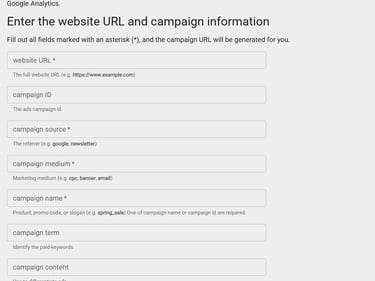
You just input the website URL and define parameters for the source (e.g., a partner publication), medium (e.g., email newsletter), and campaign name (e.g., Q4_Fund_Launch). Once you input the parameters, you get a new, trackable link.
Doing this individually for multiple links and platforms takes time. Here's a tool that can help you create UTM parameters in bulk.
For multiple links in the same campaign, you can also use Lupage Digital's tool.
Once you've done that, use these generated links in your campaigns, emails, inbound links, outbound links, etc.
To see traffic sources to your pages, check GA4 under Reports → Acquisition → Traffic Acquisition. Filter by campaign parameters (Session Medium, Session Source).
So if you're sharing any link to your website—from social media, emails, ads, or anywhere else—you should get into the habit of using UTMs immediately.
This simple fill-in-the-blank exercise can help you pinpoint those content distribution channels that generate the most leads and traffic for your business, whether you're a real estate blog writer or managing a portfolio of real estate content writing projects.
The payoff is that you stop guessing about what works, and can confidently invest your budget in channels that deliver.
CRM + lead forms tracking
CRM lead forms tracking captures information submitted by a visitor and ties it to the specific marketing that brought that visitor to your website, whether it’s from your targeted real estate SEO strategy or a specific social media campaign.
This system, which essentially falls between last-click and multi-touch attribution, is easier to set up and more cost-effective than implementing multi-touch attribution.
So, in this case, a potential investor, buyer or seller’s form submission can be connected directly back to the blog post, market report, or case study that initially brought them to your site.
You can set it up in three steps:
Embed CRM-generated forms directly on your website rather than using generic contact forms. This ensures that all submissions flow directly into your sales pipeline with full attribution data.
Doing this alone will simplify the attribution process for you. Alternatively, you could use a form creation tool that directly integrates with your CRM (without requiring third-party tools like Zapier).
Configure hidden fields to capture utm_source, utm_medium, and utm_campaign. These fields, invisible to users, will supply you with crucial attribution data. You can automate this data capture if you use a tool like Reform or HubSpot to create your forms.
The alternative is to run Google Ads and set up conversion tracking. Fire up the conversion linker tag in Google Tag Manager to get more information about anyone who fills out a form on your website.
You can even set up conversion measurement for two or more domains with Tag Manager (if you use a separate landing page - away from your main domain - for your ad campaign).
The advertising cookie you’ve set up through Google Ads tracks all their interactions on your website. So this is even more powerful. You can learn more about it here.
Essentially, you’ll get all the important attribution data you need using the hidden form fields approach.
The last step is to automate lead scoring based on content engagement patterns. A core goal of content writing for real estate is to attract high-intent prospects, and this is how you measure it.
Go to your CRM and enrich your lead data or set up lead scoring automations. Prospects who download multiple market reports or download a lead magnet after viewing a specific case study should receive higher scores than those submitting their details through the form attached to your home page.
This gives you insights into which campaigns or content pieces are generally most effective; which ones generate the highest-value leads; and which ones help shorten the sales cycle.
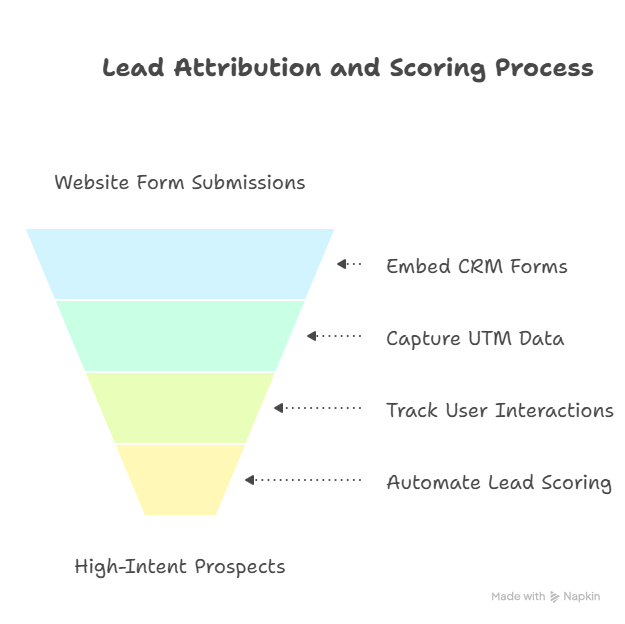

You get complete visibility into the effectiveness of your marketing efforts. You are no longer creating content in the dark.
The Value of Real Estate Content Writing in 2025
With over ten years experience writing real estate content, and five years in real estate investment content writing, the major thing I have learned is that people want to see hard numbers.
The few real estate businesses that understand this get massive value from real estate content writing. But the majority of businesses don’t.
You see too much stuff like “how to buy a house in (XYZ)” and “how to sell your house in (XYZ)”. While these are good for vying for high volume keywords, they have been over-done. And the odds of ranking for those kinds of keywords are slim.
The problem is, many of these spaghetti-on-the-wall content pieces are being created by the agencies these real estate companies outsource their marketing to. And just checking through Reddit, you’ll find dozens of stories of business owners burnt by agencies, even some big name marketing agencies.
But even in-house content creation also fails sometimes. So it’s not about having more control of the process, rather than making sure you’re using the right people for the job.
So if you’re creating content for commercial real estate investors, you should have writers who are specialists within that niche and have solid proof that they can reach commercial real estate investors through their writing.
If you hire a generic agency for your commercial real estate business, your content marketing campaign might fall flat, because they themselves would be hiring generic writers, who are unable to create content that connects with your audience.
It’s much the same as using ChatGPT. The difference is, in this case, you’re spending more.
Alright, rant done!
Real estate content that delves into the numbers for a particular city or state, or that provides sample numbers that potential buyers, sellers or investors can draw inspiration from, that’s what draws engagement.
Real estate is essentially about the numbers (stats and money). So while just talking about stuff is okay, ensure you create more content types that demand hard numbers to drive credibility and engagement.
That could be in the form of market trends and predictions, sample deal breakdowns within how-to content, sample cost breakdowns within content, general statistics based on internal data or publicly available data, calculators, or actual case studies.
If you don't know where to start, just create calculators. You can easily make one nowadays with AI tools like Perplexity and Claude or use one of the many vibe coding tools available. I created the ones on this page with Perplexity.
Current Trends in Real Estate Investment Content Marketing
1. The demand for thought leadership
You need to treat your content as a direct reflection of your team’s competence because that’s how potential clients treat it.
For a high net worth investor, your published market analysis forms a critical part of their vetting process. Your published content is a deciding factor when they’re weighing options. Does your content show clients they can trust you and your team with their money?
Thought leadership has become a fancy term for “whitepapers.” But it’s just the practice of consistently publishing insightful content that shows you understand what goes on in the minds of your potential customers, and that you and your team are knowledgeable enough to both answer their questions and quell their fears.
The online space is getting saturated with generic information, and real thought leadership is becoming scarce.
This means there is an opening for brands that can create trust by showcasing deep subject matter understanding through their content.
2. The increased importance of niche content
This follows directly from the first. The “riches are in the niches” axiom is truer now than ever.
Right now, trying to create broad content that targets everyone is a losing strategy. That’s because you end up creating surface-level content, which gets swallowed up in the vast ocean of surface-level content.
An investor focused on industrial cold storage in the Southeast doesn’t want to read a general overview of commercial real estate trends. They want to read something like “Industrial Cold Storage Trends in the Southeast.” Folks want highly specific content that speaks directly to them or their REI strategy.
You want to drill down into very specific niches or sub-niches. That is, cover specific property types, geographic regions, or investment models.
By doing this, you’ll attract a pre-qualified audience, target keywords that aren’t super-competitive and that you’ll easily rank for, and immediately establish your authority within those specific niches you target.
3. A focus on data-driven insights
Your content's value is directly tied to its ability to inform and/or validate an investor's decision. When you’re dealing with a highly educated customer base like real estate investors (about 65% of REIs have a bachelor’s degree, and over 8% have a Masters), you have to ground your content in solid data.
You can’t just offer mere opinion and hope to attract capital or get commitments from REIs. You’ll need to provide evidence. And it doesn’t always have to be original data. There are so many data sources available online. Just make sure the data you use is relevant and still applicable (either recent or evergreen).
4. The multi-channel content strategy
You need to stop thinking about content creation as a one-and-done activity. You can multiply the value of one piece of content by strategically repurposing it across different channels.
Your long-form market analysis report can be repurposed into a webinar for lead generation.
From the webinar, you could cut out short videos for social channels. You could create social posts that compel people to download the report. You could then create a “how-to” or “strategy” post for prospects that downloaded your report, showing them the practical takeaways and what they should do next.
By doing this, you meet your audience where they are, can reach more people in their preferred formats, and will potentially increase conversions. You effectively 5X or 10X the power of a single piece of content.
It’s no longer all about Google. Else, you’d put your brand in a box.
Content Performance Trends
Content marketing generates $3 for every $1 invested, compared to $1.80 for paid ads.
Content marketing leaders experience 7.8 times more site traffic than their competitors. But website traffic is a vanity metric. While having a large audience is a good start, the real measure of success is how effectively you can convert those visitors into actual leads or customers.
72% of businesses report that content marketing directly boosts lead generation, while 58% credit content marketing for generating actual sales and revenue. (SEO.com)
Content marketing costs 62% less than traditional outbound marketing, yet generates approximately three times as many leads. (SEO.com)
Almost half (47%) of marketers do not track the return on investment (ROI) from their content marketing efforts. This makes it difficult to prove its value to decision makers. So, the ability to measure and report on content marketing ROI is, in itself, a competitive advantage. (RevenueZen)
When it comes to generating awareness and top-of-funnel demand, podcasts, blog posts, and videos are the top three most effective content formats. 77% of marketers rank podcasts as the best content format for awareness content. Blog posts and articles take the second spot at 76%, while video comes third at 59%.
85% of B2B marketers use content to generate leads as opposed to just 60% of B2C marketers. (ExplodingTopics)
Let me expound a bit on the last of these SEO ROI statistics. While the B2B world has largely figured out how to use content creation to generate leads (and not just traffic), B2C industries like real estate are still trying to catch up.
This means there’s a clear opportunity to dominate B2C markets and niches if you understand content lead generation.
Content ROI vs Paid Ads vs Direct Mail
Frame your marketing investments with this crucial distinction in mind: Paid ads offer speed but they are short-term investments that stop delivering the moment you stop paying, while great content is a long-term investment that becomes an asset which builds value over time.
With marketing budgets flatlining at 7% of company revenue according to Gartner, marketers have been put in a tight spot. Do you go for the quick win or prioritize building a content library that will continue to deliver traffic and leads long into the future?
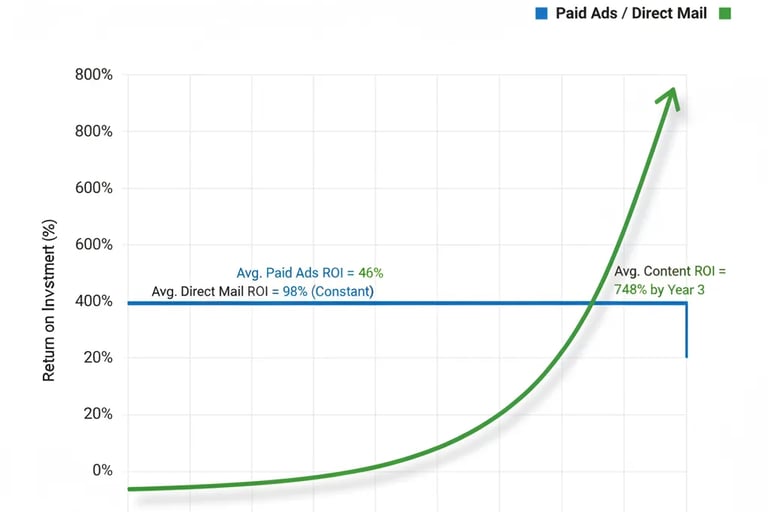

ROI comparison
Content (3-year average): 748% (Source: First Page Sage)
Paid ads (3-year average): 46% (Source: First Page Sage)
Direct mail (annual average): varies between 34% - 161% (Source: ANA)
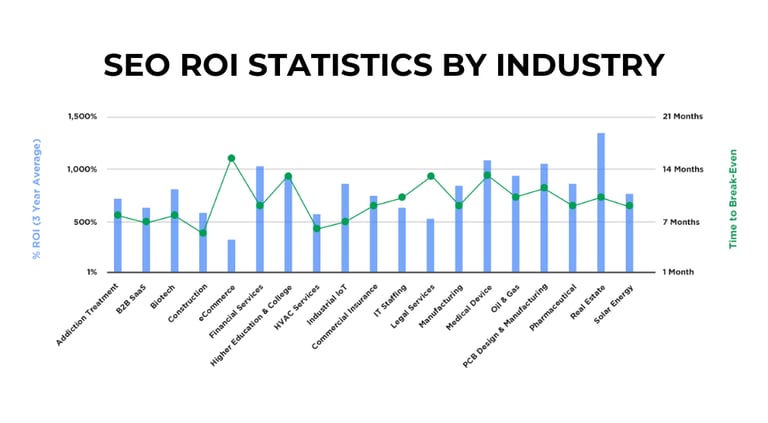

Cost Per Lead analysis
Content (real estate): $416
Paid ads (real estate): $480
Direct mail (real estate): $100 - $150 (based on this Reddit post)
Time-to-positive ROI
Content (real estate): 6-12 months to break-even, but ROI accelerates dramatically in years 2-3
Paid ads (real estate): Immediate (1-2 weeks)
Direct mail (real estate): Immediate (2-4 weeks)
Case Study 1: AppFolio’s Capital Insights Blog
Over the last two years, this blog has grown from 142,000 (August 2023) in monthly organic traffic to 231,000 per month as of August 2025 (63% growth).


Its traffic declined sharply like many other sites I assessed, with the September 2023 Helpful Content Update. But after October, it kept growing steadily.
It’s obvious that their strategy is working. It’s also worthy of note that paid traffic has been very much dwarfed by organic traffic over the years, and hasn’t seen much growth. It’s practically down from 23,000 in August 2023 to 15,000 in August 2025.
Key takeaways:
Reports: AppFolio consistently publishes thought authority pieces like “The 2024 Real Estate Investor Report”. These kinds of reports are not just great for thought leadership. They help attract links, which leads to higher rankings.
Variety of formats: AppFolio diversifies its content beyond articles to include an "Audio Series," catering to different user preferences and increasing the potential for audience engagement.
Brand authority: AppFolio is a well-known and respected name in the real estate software industry, as evidenced by numerous positive reviews and a high rating on Gartner Peer Insights. This brand authority lends credibility to their content and helps it rank higher in search results.
If you’re a software company, getting listed and having stellar reviews in places like Gartner Peer Insights, TrustPilot, and G2 could help you rank high both on search engines and AI platforms.
Customer focus trumps content length: AppFolio creates content specifically for real estate investment managers and institutional investors. Their articles are usually less than 1,500 words, but they are always targeted at the people they are trying to reach.
Creating 5,000-word pieces doesn’t guarantee success. Rather, you have to hone in on what your audience wants, and answer the questions they have.
Case Study 2: Point.com’s blog
Point.com has grown solely through organic content, from around 14,000 per month (August 2023) to over 71,000 (August 2025). That’s over 400% growth in traffic. They even saw traffic spike to over 121,000 in July.
Again, it points to the fact that content marketing, when done right and consistently, yields spectacular results. This blog stands out for its high-quality, in-depth articles on personal finance, homeownership, and home equity. The content is well-written, frequently updated, and targets a broad audience of homeowners.


Key takeaways:
Updating content is still valuable: Point.com’s strategy incorporates consistent updates for content, especially important pieces. This is necessary for YMYL niches like real estate, where rules change fast. In SEO, updating content yearly earns you trust points. This helps your rankings.
Calculators: Point’s blog features financial tools and calculators, which are effective at attracting organic traffic. Examples include the Home Appreciation calculator and HELOC interest-only calculator. These hyper-target homeowners considering cashing in on their home equity.
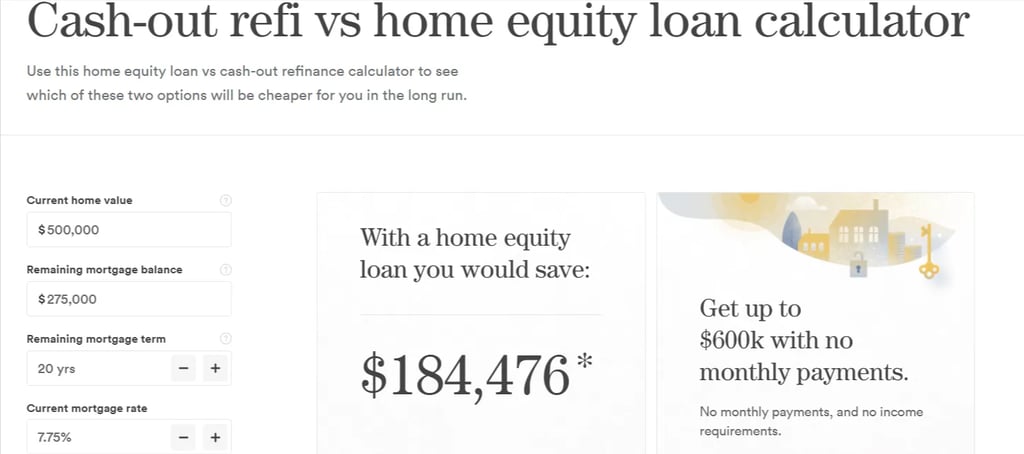

Solid content strategy: The blog has a significant amount of content on topics relevant to their homeowner audience, which is a strong indicator of a solid organic content strategy.
Point Research: Every quarter, they conduct original research or just analyze data sets from organizations like FRED or the U.S. Census Bureau, and then present these in the Point Research section of the blog. Since this is novel content, it attracts links and traffic, and boosts both thought and domain authority.
Steps to Maximize the ROI of Real Estate Content Writing
Let’s say you’re Company B and your Year 1 content marketing ROI is -33%. How do you improve your results?
Step 1: Define your ideal investor persona
The foundation of a high-ROI content program is not creativity; it is precision. You need to move beyond a superficial description of your ideal client to a deep understanding of their core motivations. This is what the folks at Harvard Business Review (HBR) call the “Job to Be Done.”
By investing capital with your firm, what “job” does an investor want done? What financial goal are they trying to move towards by allocating capital with your firm? Can you answer this question as simply as possible? When you understand the “job to be done”, you create content that resonates with your target audience and draws them in.
Tools: Start by analyzing your existing CRM data for patterns among your best clients. You can ask your sales team questions about these clients or send out surveys to them directly. You want to know what alternatives they considered or used before choosing you, why they chose you, how they found you, and why they have stayed with you. Pay attention to the verbs they use as these signal “jobs.”
Next, use a tool like SparkToro to identify their trusted information sources—the specific publications and podcasts they consume.
Finally, look at forums, Facebook, and LinkedIn groups to see what questions people are asking and the conversations they have about your products, services, or your competitors. You can also check out competitor reviews to decipher the “jobs” people want done.
Time estimate: This is not a one-day exercise. You should dedicate 2-4 weeks to comprehensive research, data analysis, and conducting interviews with a small sample of your current, best clients. You should take this seriously as it will set the tone for most of your content efforts for years to come. It’s how you pre-empt wasting money.
Expected outcome: At the end of this exercise, you should have a brief that details your ideal client’s primary goals, pain points, objections (or risk tolerance), and their information consumption habits. This ensures every dollar of your content budget is spent creating assets that directly address their needs and are distributed across the channels they consistently use.
Step 2: Keyword research focused on investor intent
Now that you know the jobs or problems you should be solving, you want to identify the specific phrases that a serious real estate investor would use when researching partners or companies.
That’s the problem with broad terms like “real estate investment.” They may generate high visitor numbers because they are high volume keywords. But the traffic generated is low-value and less likely to convert into leads.
If you want positive ROI from content creation, the bulk of your content creation efforts should be focused on those specific, high-intent queries that signal a prospect is in the research phase or wants a solution to those problems you identified in step 1. This is truer now than ever.
Tools: Use professional SEO tools like Ahrefs and Semrush to analyze the exact terms driving traffic to your competitors and industry leaders. Personally, I stick to Google Keywords Planner and Ahrefs for keyword research.
Supplement your main keyword research tools with a tool like AnswerThePublic or Google’s People Also Ask to uncover the specific, long-tail questions your ideal customer is asking.
Time estimate: Dedicate one week to deep keyword and questions research.
Expected outcome: You will have a clear, targeted list of high-intent keywords to focus on. This list will become the building blocks of your content strategy. By ranking for some of these keywords, you’ll attract qualified investors who are actively in the research stage or looking for the solutions you offer.
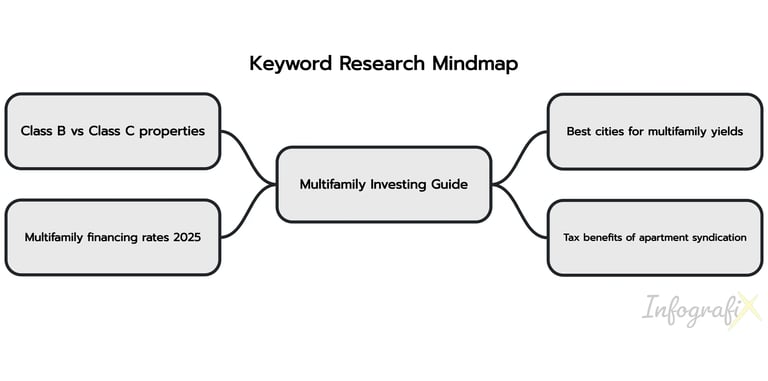

Step 3: Develop a content calendar aligned with your customer’s journey
Most people think a content calendar is just a publishing schedule; it’s not. It’s a strategic blueprint for building a relationship with potential prospects through your content.
For a residential REI firm providing turnkey property investments or loans to property investors, your content calendar has to map each content asset against the specific journey stages an investor follows when they plan to engage or engage with your firm.
That is, from initial awareness of a problem, need, or goal they’d like to achieve (with educational content), to consideration of solutions and options (comparison, webinars, case studies, and costs), to a final investment decision (free consultation, or pre-qualification survey).
Tools: Use Airtable's content calendar template to build visual, flexible calendars that map each content piece to specific investor journey stages and business goals.
Time estimate: Set apart 1-2 weeks each quarter to conduct keyword and competitor research, and to build out your content roadmap for each quarter (90 days).
Expected outcome: By building out your content strategy this way, based on your ideal client’s journey, you create a mechanism that turns content marketing from a business expense into a revenue-generating asset for your business.
Step 4: Optimize content for SEO & user experience
You should understand that even the best content is worthless if no one can find it or if they can't quickly grasp its value when they do. This is why SEO and User Experience (UX) are essential if you want to create content assets that deliver a return.
As definitive research from the Nielsen Norman Group shows, users on the web do not read; they scan. Hence, your content must be structured for this reality with clear and concise headings, short paragraphs, and bolded key points.
Nowadays, SEO gets a bad rep because of Google. And rightly so, because in the last couple of years, Google has made some experiments that have been detrimental to its business model and also to the thousands of companies that depend on it for traffic.
So while you shouldn’t place all your eggs in Google’s basket, you can’t afford to ignore SEO altogether.
Regardless of the hype about AI search, Google is still the dominant search engine, sending the bulk of traffic to most sites and publishers (at least 210X more than ChatGPT, Perplexity, and Gemini combined).
Tools:
Use Ahrefs' Site Audit to identify technical SEO issues affecting content performance, from slow load times to broken internal links.
Implement structured data (schema) markup for real estate content.
Optimize each piece of content for relevant keywords.
Measure your site's performance and user experience with Google's PageSpeed Insights.
Build links through both guest posting and data-driven content creation.
Time estimate: Initial technical SEO audit and implementation can take 2-4 weeks. But SEO optimization is largely an ongoing process.
You should devote 1 week every 6 months to performing a comprehensive SEO audit and implementing needed changes. Large firms, creating lots of content, may need to do this every month, and will probably have someone on staff for this.
Expected outcome: The work you put into SEO and optimizing your user experience will not just lead to improved search engine rankings, and subsequently an increase in quality organic traffic, it will result in higher engagement and better message retention. This subtly increases the chance that a qualified visitor will take the next step with you.
Step 5: Promote content across multiple channels
Creating and publishing content is only half the work. The next critical task is to actively promote it across multiple channels. It's this strategic distribution that truly unlocks your content's value, transforming it from something that just sits on your website into a dynamic tool that actively works to bring in new business.
Distribution should be twofold: immediate engagement through direct channels and long-term authority building through search engines.
The most critical component of the second part is building backlinks through a process of digital PR, where your data and insights are cited and linked to by respected industry publications. This is something many firms ignore.
Tools: Get some immediate traffic by sharing your content on platforms like LinkedIn, X, IG, Pinterest, Threads, and Facebook. For higher SEO rankings, you should build backlinks to increase your domain authority.
You can use a tool like Semrush or Ahrefs to identify relevant industry publications for outreach and to track your backlink acquisitions.
Time estimate: Content distribution is an ongoing, weekly process. Dedicate 3-5 hours per week to social content creation. Hire someone internally, an agency or a specialized freelancer for targeted outreaches.
Expected outcome: You will have a promotion system that can consistently and automatically deliver traffic and leads for your business from each piece of solid content.
Step 6: Track, analyze, and iterate
You have to continuously measure the performance of your content assets against the goals of traffic, lead generation, and ultimately, new client acquisition.
Tools: Use Google Analytics to monitor core performance metrics like traffic and conversions. Consolidate this data into a high-level executive dashboard using a tool like Google Looker Studio. Conduct a formal content audit on a quarterly basis to evaluate your entire content portfolio.
Time estimate: Dedicate 2-4 hours monthly for performance reviews and 1-2 days quarterly for a deeper strategic audit.
Expected outcome: By consistently analyzing what delivers real business results, you empower yourself to make smarter decisions, stop funding underperforming efforts, and steadily increase the overall return on your content investment.
Costly Errors that Lead to Poor ROI in Real Estate Content Marketing
Now that we’ve seen the right way Company B should go about improving their content marketing results, let’s see what most firms in Company B’s position do that keeps their content investments going down the drain.
Pitfall 1: Content operations without a strategy
This is the primary cause of failure. According to research from the Content Marketing Institute, the most successful B2B marketers are vastly more likely to have a documented content strategy. Operating without one is akin to deploying capital without an investment thesis—it ensures resources are misallocated, audiences are missed, and goals are never met.
Pitfall 2: Diluting your brand with low-value content assets
For a sophisticated investor, generic, poorly researched content is a direct signal of a lack of expertise. This type of content does not just fail to attract leads; it actively erodes the trust and credibility that are essential for attracting and retaining capital.
Every low-value asset you produce is a withdrawal from your brand's authority. Content writing for real estate websites should always prioritize depth, accuracy, and relevance.
Pitfall 3: Neglecting SEO
This is the equivalent of constructing a trophy property with no road access. Your content, no matter how insightful, is commercially unviable if investors cannot find it. Real estate SEO is not optional—it’s the foundation for visibility and lead generation.
Pitfall 4: Inconsistent publishing schedule
Content is a compounding asset that requires consistent investment to grow. An erratic publishing schedule (January, then April) breaks momentum, signals a lack of commitment, and hinders your ability to build trust with both search engines and prospects.
Pro-tip: When you can’t publish new posts, just update the old ones. Search engines favor sites with consistent, fresh content.
Pitfall 5: Ignoring data and analytics
Operating without analytics is like managing a portfolio without financial statements. It makes it impossible to distinguish high-performing content from under-performing assets. Without this knowledge, you can’t optimize your budget and this leaves you unable to prove the connection between your content investment and your revenue.
Conclusion
Congrats! You now have the framework and tools to move your real estate content strategy from “meh” to great. You are now equipped to solve the measurement problem that prevents 80% of firms from capturing returns from their content.
With an average SEO ROI of 1,389%, real estate stands to gain the most from content marketing, but only through a strategic, data-driven approach.
The opportunity in 2025 is that while many others keep diluting their brands with low-value content, you should be doubling down on high-quality content writing to attract qualified investors, build brand authority, and maximize your returns in 2025 and 2026.
If you manage content for a residential real estate investment firm and want an in-depth review of your content strategy, fill out this form.


Agnes Gaddis is an experienced real estate content writer, helping residential real estate investing brands boost traffic and visibility through content. You can read her articles on SparkRental, Inman, Bankrate, RealWealth, Credit.com, and more.


